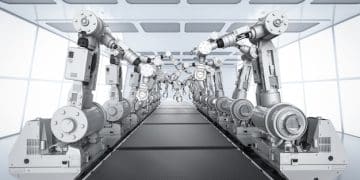AI in Renewable Energy: Optimizing US Energy Production

AI in Renewable Energy: Optimizing Energy Production and Distribution in the US involves utilizing artificial intelligence to enhance the efficiency, reliability, and sustainability of renewable energy sources like solar, wind, and hydropower, leading to more effective energy management and reduced carbon emissions.
Harnessing the power of renewable energy is critical for a sustainable future in the US. Integrating AI in Renewable Energy: Optimizing Energy Production and Distribution in the US presents unprecedented opportunities to revolutionize how we generate, distribute, and manage clean energy, making it more efficient and accessible than ever before.
The Promise of AI in Renewable Energy
The integration of artificial intelligence (AI) into the renewable energy sector is transforming traditional approaches to energy production and distribution. AI offers solutions to some of the most pressing challenges faced by the industry, enhancing efficiency, reducing costs, and improving overall reliability. This section explores the fundamental benefits and promises that AI brings to renewable energy in the US.
Enhanced Efficiency and Output
AI algorithms can analyze vast amounts of data from renewable energy systems to optimize their performance. Whether it’s a solar panel installation or a wind farm, AI can make precise adjustments to maximize energy output, leading to a more efficient use of resources.
Predictive Maintenance
One of the key benefits of AI is its ability to predict when equipment might fail. By monitoring the performance of turbines, solar panels, and other components, AI can anticipate maintenance needs, reducing downtime and lowering maintenance costs.

Here are some key areas where AI is making a significant impact:
- Smart Grids: AI optimizes energy distribution across the grid, reducing waste and ensuring a stable supply.
- Energy Forecasting: AI provides accurate predictions of energy demand, helping utilities better manage resources.
- Autonomous Operations: AI enables renewable energy systems to operate more autonomously, reducing the need for human intervention.
In summary, AI’s potential to enhance efficiency, predict maintenance needs, and optimize energy distribution makes it an indispensable tool for the future of renewable energy in the US.
Optimizing Wind Energy with AI
Wind energy is a vital component of the renewable energy mix in the US. AI is playing an increasingly important role in optimizing wind energy production by improving turbine efficiency and enhancing grid integration. This section delves into the specific ways AI is being used to maximize the potential of wind power.
AI can analyze data related to weather patterns, turbine performance, and grid demand. This information is used to optimize turbine settings in real-time, ensuring that the turbines are always operating at peak efficiency.
AI-Driven Turbine Control
AI algorithms adjust the pitch and yaw of wind turbines to maximize energy capture, optimizing performance based on current weather conditions.
Predictive Maintenance for Turbines
AI can identify anomalies in turbine operation, predicting maintenance needs before they lead to costly downtime. This ensures that turbines are always operating at their best.

Consider these use cases of AI in wind energy:
- Real-time Optimization: Dynamic adjustments based on current conditions to maximize energy yield.
- Anomaly Detection: Identifying and resolving potential issues before they escalate.
- Grid Balancing: Coordinating wind energy output with overall grid demand.
By leveraging AI, wind energy producers can significantly increase their output, reduce maintenance costs, and contribute more effectively to the nation’s clean energy goals. AI is not just an enhancement; it’s a transformative force in wind energy.
Enhancing Solar Energy Production Using AI
Solar energy is another cornerstone of renewable energy in the US. AI is revolutionizing solar energy production by optimizing panel efficiency, improving energy storage solutions, and enhancing grid integration. This section explores how AI is being used to unlock the full potential of solar power.
AI can analyze data from solar panels, weather forecasts, and energy grids to optimize solar energy production. This includes improving panel orientation, predicting energy output, and managing battery storage effectively.
Optimized Panel Orientation
AI algorithms adjust the orientation of solar panels throughout the day to maximize sunlight capture, enhancing energy production.
Predictive Energy Output
AI provides accurate forecasts of solar energy output, improving grid stability and ensuring a reliable supply of power.
Key benefits of AI in solar energy include:
- Improved Efficiency: Maximizing energy capture through dynamic panel adjustments.
- Enhanced Storage: Optimizing battery usage based on predicted energy needs.
- Seamless Grid Integration: Ensuring smooth and reliable energy delivery to the grid.
AI is driving significant advancements in solar energy, leading to increased efficiency, improved reliability, and better integration with the overall energy grid. This makes solar energy a more viable and sustainable option for powering the US.
AI-Driven Smart Grids for Renewable Energy Distribution
Smart grids are essential for integrating renewable energy sources into the existing power infrastructure. AI plays a crucial role in managing and optimizing these complex networks, ensuring efficient and reliable energy distribution. This section examines how AI is transforming grid management and enabling a more sustainable energy future.
AI is used to manage complex energy flows, balance supply and demand, and reduce energy waste. By analyzing vast amounts of data in real-time, AI can make intelligent decisions to optimize grid performance.
Real-Time Energy Management
AI systems monitor energy demand and supply, making instantaneous adjustments to balance the grid and prevent outages.
Predictive Grid Maintenance
AI can anticipate potential issues within the grid, allowing for proactive maintenance and preventing disruptions to energy supply.
Consider these capabilities of AI in smart grids:
- Demand Response: Dynamically adjusting energy consumption based on grid conditions.
- Fault Detection: Identifying and isolating faults to minimize disruptions.
- Energy Storage Optimization: Managing battery storage to enhance grid stability.
AI-driven smart grids are transforming energy distribution, making it more efficient, reliable, and sustainable. By continuously optimizing grid performance, AI ensures that renewable energy sources can be effectively integrated into the power infrastructure, supporting a greener future.
Challenges and Opportunities for AI in Renewable Energy
While the potential of AI in renewable energy is immense, there are challenges to overcome and opportunities to seize. Addressing these challenges and capitalizing on the opportunities is crucial for realizing the full benefits of AI in this sector. This section provides an overview of the key challenges and opportunities that lie ahead.
Challenges include data privacy concerns, the need for robust cybersecurity measures, and the potential for biases in AI algorithms. Overcoming these challenges is essential for ensuring the responsible and effective use of AI in renewable energy.
Data Privacy and Security
Ensuring the privacy of energy consumption data and protecting against cyber threats is paramount. Robust cybersecurity measures and data anonymization techniques are necessary to mitigate these risks.
Algorithmic Bias
AI algorithms can sometimes exhibit biases, leading to unfair or inefficient outcomes. It is important to address these biases through careful algorithm design and ongoing monitoring.
Opportunities for AI in renewable energy include:
- Edge Computing: Processing data closer to the source to reduce latency and improve real-time decision-making.
- Digital Twinning: Creating virtual replicas of energy systems for simulation and optimization.
- AI-Driven Policy: Informing energy policy decisions with data-driven insights.
Despite the challenges, the opportunities for AI in renewable energy are vast. By addressing the challenges and capitalizing on these opportunities, the US can accelerate the transition to a sustainable energy future.
The Future of Renewable Energy with AI
The future of renewable energy is inextricably linked to the advancement of AI. As AI technology continues to evolve, its role in optimizing energy production, distribution, and consumption will only grow. This section explores the future possibilities and potential impact of AI in the renewable energy sector.
AI is expected to play an increasingly important role in optimizing energy systems, predicting energy demand, and managing smart grids. This will lead to a more efficient, reliable, and sustainable energy future for the US.
Advanced Forecasting
AI will provide increasingly accurate forecasts of energy demand and supply, enabling better resource management and grid stability.
Autonomous Energy Systems
AI will enable renewable energy systems to operate more autonomously, reducing the need for human intervention and improving overall efficiency.
Key trends to watch include:
- Decentralized Energy: AI managing microgrids and distributed energy resources.
- Personalized Energy Management: AI optimizing energy consumption at the individual level.
- AI-Driven Innovation: Continuous advancements in energy technology driven by AI insights.
The future of renewable energy with AI is bright. As AI technology continues to advance, it will play an increasingly critical role in creating a sustainable and efficient energy future for the US, ensuring that clean energy is accessible and reliable for all.
| Key Point | Brief Description |
|---|---|
| 💡 AI Efficiency | AI enhances renewable energy efficiency via real-time optimization. |
| ⚙️ Maintenance | AI predicts maintenance needs, reducing downtime and costs. |
| ⚡ Smart Grids | AI manages energy flow in smart grids for balanced distribution. |
| ☀️ Solar Boost | AI maximizes solar panel output by optimizing angles. |
Frequently Asked Questions
AI enhances wind turbine efficiency by optimizing turbine settings in real-time based on weather data, maximizing energy capture and reducing wear and tear, ultimately boosting the turbine’s overall performance.
AI improves solar energy production by optimizing panel orientation, predicting energy output, and enhancing grid integration, leading to increased efficiency and reliable energy delivery from solar installations.
Smart grids benefit from AI through real-time energy management, predictive grid maintenance, and demand response capabilities, ensuring efficient, reliable, and sustainable energy distribution across the network.
The main challenges include data privacy concerns, ensuring robust cybersecurity, and addressing potential biases in AI algorithms to guarantee responsible and effective AI use in the renewable energy sector.
Future trends include decentralized energy management through AI-managed microgrids, personalized energy consumption optimization, and continuous innovation in energy technology driven by AI insights for a sustainable future.
Conclusion
In conclusion, the integration of AI in Renewable Energy: Optimizing Energy Production and Distribution in the US holds tremendous promise for enhancing efficiency, reliability, and sustainability. By addressing the challenges and capitalizing on the opportunities, the US can accelerate the transition to a cleaner, more efficient, and sustainable energy future.





